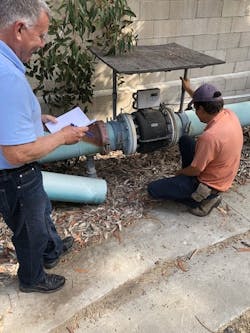Lisa Ohlund is general manager of East Orange County Water District. Ohlund can be reached at [email protected] or 714.538.5815. Paul Findley is business development director at Water Pigeon Inc. Findley can be reached at [email protected] or 858.248.1823.
undefinedEast Orange County Water District (EOCWD) is located in Orange, Calif. and provides wholesale water service to a population of more than 100,000, retail sewer service to greater than 80,000 and retail water service to approximately 5,000 customers through 1,200 connections. The district prides itself on providing hometown service by being fiscally disciplined and providing direct accountability.
More Water Purchased Than Sold?
The district wholesale operation includes providing water to their retail operation and to other retail water agencies through 18 different metered connections at scattered locations throughout the district’s service area. All of the water that the district provides to its wholesale customers comes through three master meters owned and operated by another agency.
The problem was that the amount of water the district purchased on a monthly basis through the master meters was higher than the total amount of water that it delivered to its wholesale customers. The district verified that there was no significant system leakage between the master meters and the district’s wholesale meters.
Mass Balance Challenge
The exact magnitude of this discrepancy could not be readily determined because it was not possible to read all of the meters at the same time as the monthly billing reading of the master meter, which is read at 12 a.m. on the first day of every month. Because the district’s wholesale meters were not equipped with a SCADA system or an automated meter reading (AMR) and advanced metering infrastructure (AMI) system. The staff were taking manual readings of these meters several hours after the master
meter reading.
These readings could not be time-synced with the reading on the master meter, therefore, the district could not prepare an accurate mass balance to accurately quantify the metered water discrepancy. Additionally, the staff time required to access and read the meters was a time-consuming
monthly burden.
The district needed an automated synchronous meter reading system that would read all of the meters at the same time as the reading on the master meter. All of the meters were equipped with digital readouts on LCD displays mounted either on the vault wall or in cabinets near the vault. However, the meters were from several different manufacturers with different communication protocols. The district tried an AMI system that attempted to read and communicate all of the existing meters on a single platform, but this proved infeasible.
Optical Technology Solution
To solve this, EOCWD installed an optical AMR system called Water Pigeon. This technology takes images of the register at several specifically scheduled times during the day and transmits the images to the cloud via existing cellular networks. The images are then read, and the readings and water usage at each meter are displayed on a web-accessible dashboard. The images (readings) were taken six times per day (every four hours), and uploaded to the cloud twice per day.
Simultaneous readings were collected at 12 a.m. on Dec. 1, 2018, and then again on Jan. 1, 2018 and these readings allowed the district to complete a mass balance calculation for December. Since then, simultaneous readings have been collected on Feb. 1, 2019 and Mar. 1, 2019.
Initially, the images were taken six times per day. As a result of the initial successful deployment, the district decided to increase the number of readings to 24 readings per day. The data provided by this new reading schedule were given to a modeling team, which is investigating water aging in the system and its associated impact on water quality parameters, such as combined chlorine residual and disinfection byproducts.
The device is about the size and shape of a paperback book. It contains a camera, LED lights, a cellular modem and SIM card, firmware and software for communication and optical character recognition, and a battery rated for approximately 7,500 connections to the cloud (approximately 10 years at two connections per day). The unit is equipped with an internal antenna but also can be connected to an external antenna.
Because the technology is designed to read existing meters, it eliminated the time and cost to replace existing meters or meter peripherals. Some of the wholesale meters were equipped with separate LCD displays that were mounted on the wall near the top of the vault. For these, the units were mounted on aluminum brackets facing the LCD display and the units were connected to existing antennas that had been installed as part of the previous failed attempt at AMI.
The LCD displays for the other wholesale meters were mounted in separate above-ground cabinets near the vault. If the cabinet was deep enough, the device was mounted inside the cabinet. If not, the they were mounted on the outside of the cabinets, using existing viewing windows in the cabinet door. An external antenna was not required for the units mounted in or on the cabinets.
The wholesale meters are read by both EOCWD and the staff of the wholesale customers. Water Pigeon has provided access to the dashboard to all wholesale customers for review of meter readings. In addition to providing the wholesale customer with more frequent readings, this eliminates trips by the customer to manually read the meter.
Achieving Balance
The district now has a system in place that will provide the information it needs to complete the monthly mass balances and to more exactly quantify the problem so that it can be addressed with facilities and operations improvements.
The district now has multiple readings per day at each meter, leading to better understanding of the water delivery requirements for the district and for each of its wholesale customers. The district is considering expanding the system for use on its retail customers.


